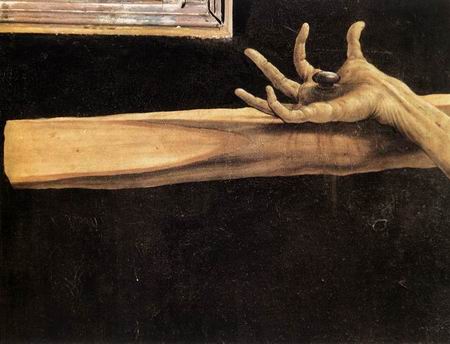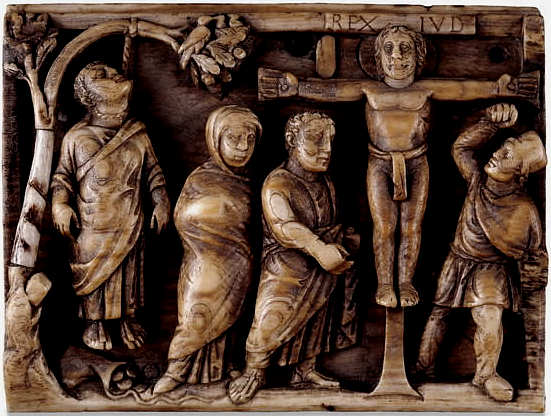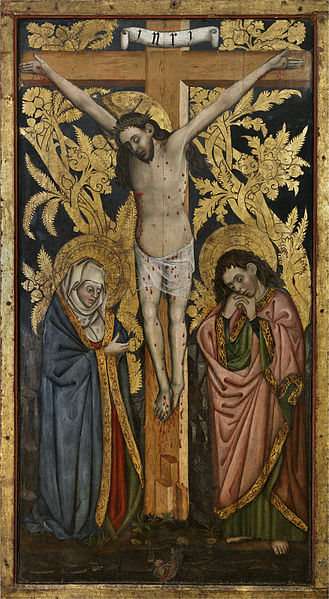
For he grew up before him like a young plant,
and like a root out of dry ground;
he had no form or majesty that we should look at him,
nothing in his appearance that we should desire him.He was despised and rejected by others;
a man of suffering and acquainted with infirmity;
and as one from whom others hide their faces
he was despised, and we held him of no account.
He grew up like a sapling before him,
like a shoot from the parched earth;
He had no majestic bearing to catch our eye,
no beauty to draw us to him.He was spurned and avoided by men,
a man of suffering, knowing pain,
Like one from whom you turn your face,
spurned, and we held him in no esteem.—Isaiah 53: 2-3
Look at Him
When I was in first grade, I think it was, my parents opened a Catholic store. That store defined my childhood in many ways from the long Saturdays I spend hiding in the corner reading book after book, to the hours I spent labeling merchandise, to the hours I spent as a teen doing inventory and waiting on customers. This isn’t really about that store except indirectly as many of my dad’s stories come from various customers. And those stories, too, are a part of my life.
One story my dad loves to tell is about a woman who came into the store one day asking for “a hospital crucifix”. It took some sleuthing but eventually he found the one she wanted in a catalog. Curious, he asked her story. She had suffered from a stroke and when she woke up in the hospital and opened her eyes there was this crucifix directly in her line of sight. She was paralyzed and so could not turn her head to see anything else. The only thing she could do was to look at the image of Jesus on the cross. And it was practically burned into her mind. She hadn’t been religious at all before the stroke, but she told my dad that since being discharged from the hospital she had been hungry for the Eucharist. She was in an RCIA program, preparing to enter the Catholic Church. She told this story to him with tears in her eyes and my dad, who at the time was quite moved by her story, has since suffered a stroke himself and tells the story while looking a little misty-eyed himself.
Yet it was our pain that he bore,
our sufferings he endured.
We thought of him as stricken,
struck down by God* and afflicted,But he was pierced for our sins,
crushed for our iniquity.
He bore the punishment that makes us whole,
by his wounds we were healed.—Isaiah 53: 4-5
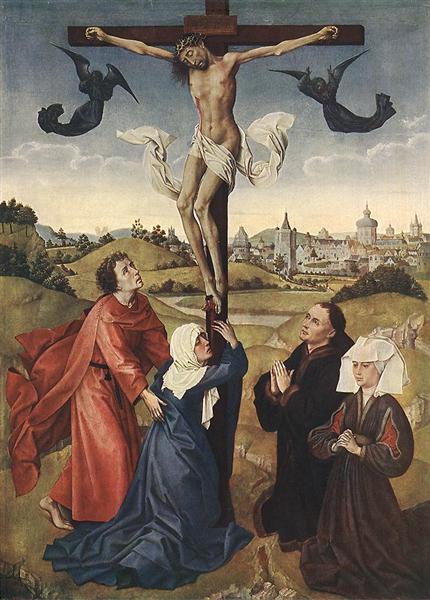
Another story my father tells again and again is of a priest who used to come into the store and buy dozens of the small, cheap crucifixes, the kind you can hang on a cord around your neck. One day Dad was curious and asked him what he did with them all. Well, it seems the priest was a hospital chaplain and when he visited patients, especially those who were suffering great pain, he would hand them one of the crucifixes he kept in his pocket and tell them, “Look at Him.” Nothing more. Just look at him. It didn’t matter whether they were Catholic or not, religious or not. Just, here, look at Him. He was preaching Christ crucified with deeds more than words, offering the greatest, the only, consolation for human suffering. Look at Him.
We had all gone astray like sheep,
all following our own way;
But the LORD laid upon him
the guilt of us all.Though harshly treated, he submitted
and did not open his mouth;
Like a lamb led to slaughter
or a sheep silent before shearers,
he did not open his mouth. —Isaiah 53: 6-7
I’ve never wanted a tattoo, never understood the appeal, to be honest. But recently Elizabeth Scalia shared a story about an Egyptian mummy that was found with a tattoo representing St Michael. In the comments to that she also shared a story about an article about a family in Jerusalem that has been tattooing pilgrims for hundreds of years. Elizabeth said that she has been inspired to consider getting a tattoo of a Jerusalem cross as a sort of compensation for not getting to go to Jerusalem on pilgrimage.
In the comments a woman shared her story, how she’d had surgery and wanted to get a cross tattoo at the incision on her wrist where they’d inserted a line to her heart. The tattoo would be a memorial, not only a reminder of her ordeal, but also a symbolic statement. She confessed that a secondary reason she wanted a cross tattoo was because she had a fear of dementia. In her own words:
[My tattoo] was to mark the fading scar from an entry to my radial artery during an angiogram–literally, a pathway directly to the inside of my heart, a very profound experience. I chose the “croix pomme” used in an architectural element of my church. Later, gazing on the Shroud of Turin, I was struck by the distinct blood stain on the wrist at the very same point. And now I discover it’s a “thing” with one of the poorest, most marginalized and most ancient Christian communities in the world; have spent over an hour exploring the lives of the Copts who live on the outskirts of Cairo as the city’s garbage collectors (“zabbadeen”). The tat just keeps becoming more meaningful for me.My other motivation, weird maybe, was my rather morbid fear of dementia. I find it comforting to think that, God forbid, if I am ever confined to a bed and forget everything else, or unable to communicate, I can have that symbol literally right at hand. Have been thinking of adding (because one always thinks of adding, whether or not one denies it): “I am the Way.”
I really love the symbolism as Christ the Way, the king of her heart, and also of the Cross as a symbol of solidarity with the poor. And the secondary motivation resonated with me, too— the fear of dementia and of having everything taken away, but having the cross to cling to. I was reminded of my dad’s story about the priest who handed out crucifixes. “Look at him.” The fear that she could be trapped in a state where she wouldn’t have the ability to gaze on Him. Her desire to provide a constant visual prompt for herself, a cross that could not be taken away from her. I can imagine myself alone and drifting in time and in memory and how that tattooed cross could really be a sort of life raft.
I was moved by her desired to cling to the cross at all cost, to remain close to the crucified Christ in her bodily infirmity, and to unite her sufferings with His.
I will rise now and go about the city,
in the streets and in the squares;
I will seek him whom my soul loves.. . .
I sought him, but found him not.
The sentinels found me,
as they went about in the city.
“Have you seen him whom my soul loves?”Scarcely had I passed them,
when I found him whom my soul loves.
I held him, and would not let him go
until I brought him into my mother’s house,
and into the chamber of her that conceived me.I adjure you, O daughters of Jerusalem,
if you find my beloved,
tell him this:
I am faint with love.–Song of Songs 3: 2-4; 5:8
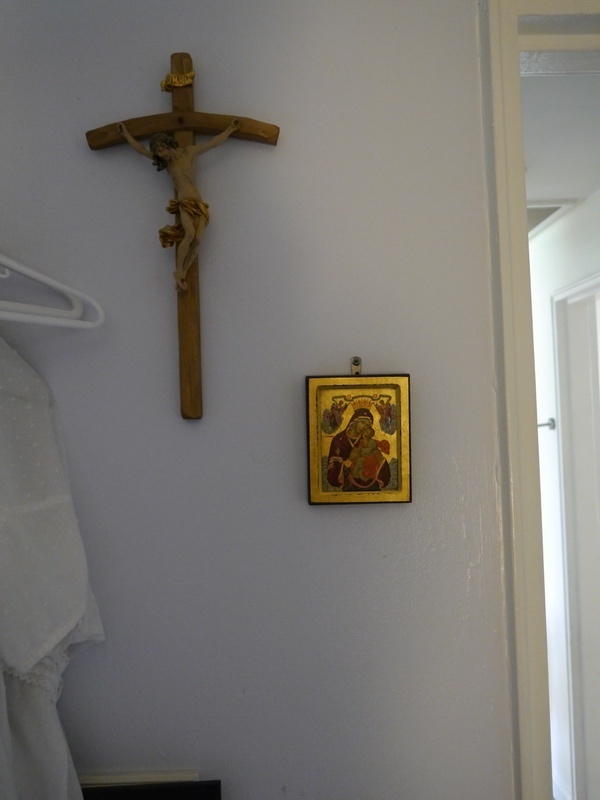
Long ago when Bella was just a toddler and Sophie a wee baby I wanted very much to have a statue of Mary and a crucifix for every room of the house. And in answer to my prayers the archdiocese had a garage sale, open to employees, which Dom was at the time, and there I got for free a beautiful but very chipped statue of Our Lady of Grace and a handful of old worn crucifixes, the kind that probably hung in offices or classrooms. When we moved into our house I found that I had a crucifix for every room of the house. This was important to me. I’m not much of an interior decorator. I’m not a huge fan of family photos which eventually look faded and dated. The family pictures I wanted on my walls the most aren’t old pictures of my kids, but images of Mary and the saints and, most of all, the cross. It’s a deliberate message I’m sending to my children, to my husband, to myself, to any visitors who enter our house. Here he is. Look at Him. This is what matters. This is where we put our trust.
I don’t look at them often. They are often taken for granted. But some mornings when I wake and I’m fumbling for prayer and in my sleep fogged way having trouble getting there, I lift my eyes to the crucifix and look at Him. It’s not much of a prayer, but there it is. I’m looking at my Beloved, raising my eyes to Him from whom comes my help. It’s not much, but then again maybe it’s everything.
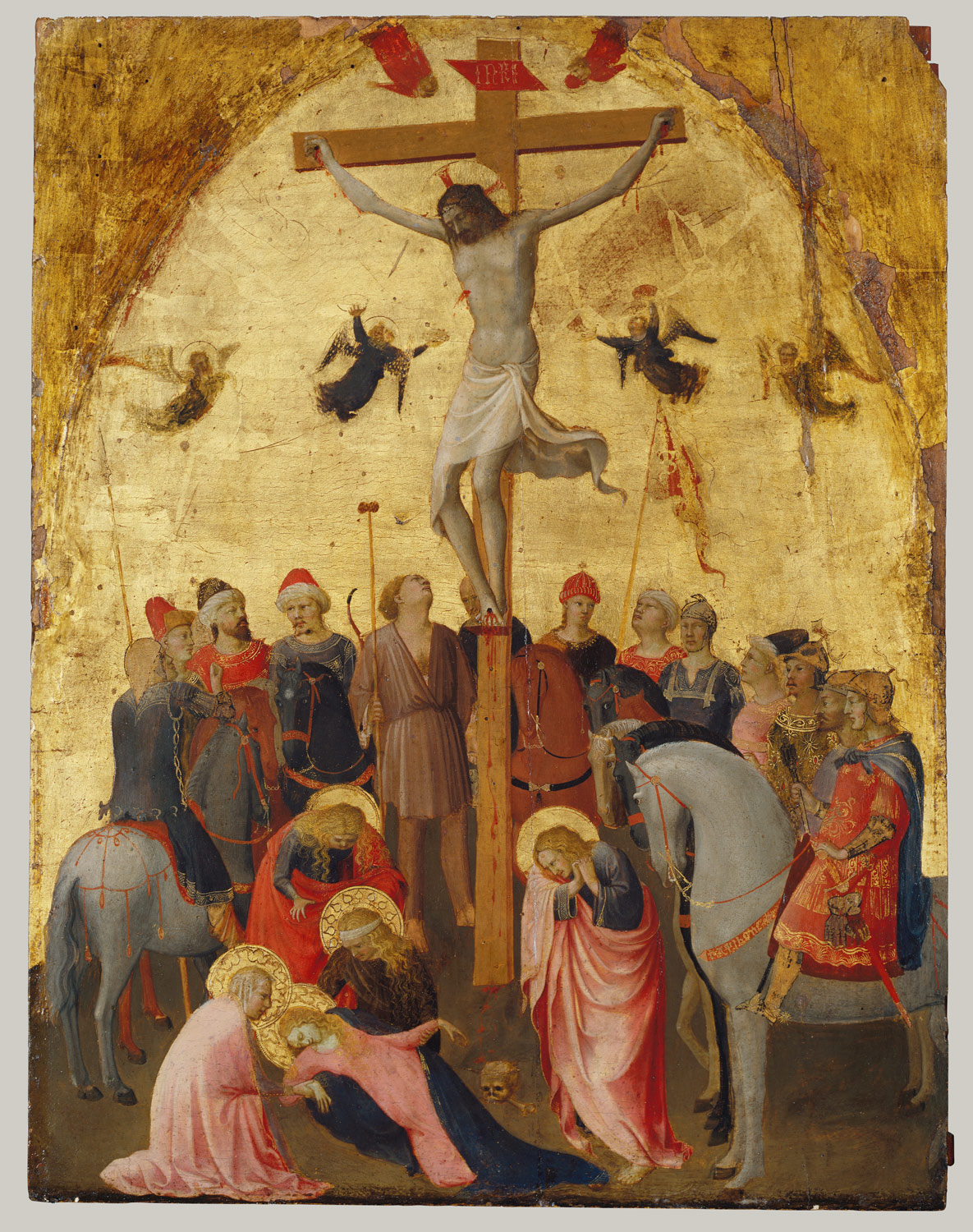
It’s a Friday in Lent and the children and I gather to pray the Stations of the Cross in the living room. Every child has a prayer book, we have printed cards with the stations, too, laying on the coffee table with fourteen candles. The children will snuff one candle after every station. I pull the large crucifix from the wall and hand Jesus to a child to carry in procession as we sing Lift High the Cross. The other children want crosses too and find them on the walls over their beds, palm crosses from last year’s Palm Sunday, somewhere they manage to find a cross to hold. Look at him, I want to say, but I let the prayers say it for me. It’s a long praying. Lots of standing and kneeling. The children grow tired and restive by the end. But eery year they are eager for this. A way to draw close to the cross, to focus our attention on the Crucified Christ.
And on Easter morning will they remember this or see the echo when they unwrap their chocolate crosses and taste the sweetness? Will they see the connection?
But it was the LORD’s will to crush him with pain.
By making his life as a reparation offering,
he shall see his offspring, shall lengthen his days,
and the LORD’s will shall be accomplished through him.Because of his anguish he shall see the light;
because of his knowledge he shall be content;
My servant, the just one, shall justify the many,
their iniquity he shall bear. Therefore I will give him his portion among the many,
and he shall divide the spoils with the mighty,
Because he surrendered himself to death,
was counted among the transgressors,
Bore the sins of many,
and interceded for the transgressors.
—Isaiah 53:10-12
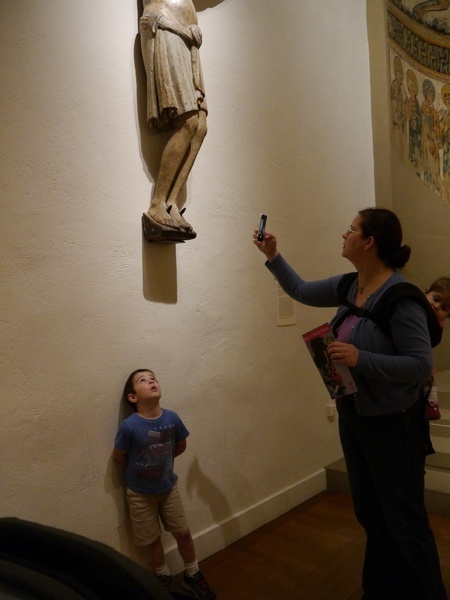
It’s strange and a bit disorienting to see a crucifix in a museum. Do I admire it as a work of art, or do I prostrate myself and adore? This piece was undoubtedly created to hang in a church, to be the focus of prayer, to inspire devotion and love. And here, divorced from context, can I truly see Him?
It’s so easy to look at the cross without seeing Christ. It’s such a familiar image, almost a comfortable image. It takes having children for me to see him anew.
Mama, why is Jesus on the Cross?
But he’s going to come down?
He’s not really dead?
Does it hurt?
When Bella was a toddler part of her nightly ritual at bedtime was kissing the cross. I’d take down the cross that hung on her wall above the crib and I’d kiss it and she’d imitate me. I think at some point all of my children did it. The cross on the wall near my door. Goodnight Jesus. I love you, I’d say. And they’d echo: Jeesh. Jesus. A first word. The first devotion. The first prayer a toddler prays. The sign of the cross, toddler hands fumbling at forehead, belly, shoulders. This cross. Look at him. He loves you. Goodnight, dear Jesus, goodnight.

. . .when they look on him whom they have pierced, they shall mourn for him, as one mourns for an only child, and weep bitterly over him, as one weeps over a first-born. —Zechariah 12:10
Ave, crux, spes unica.

